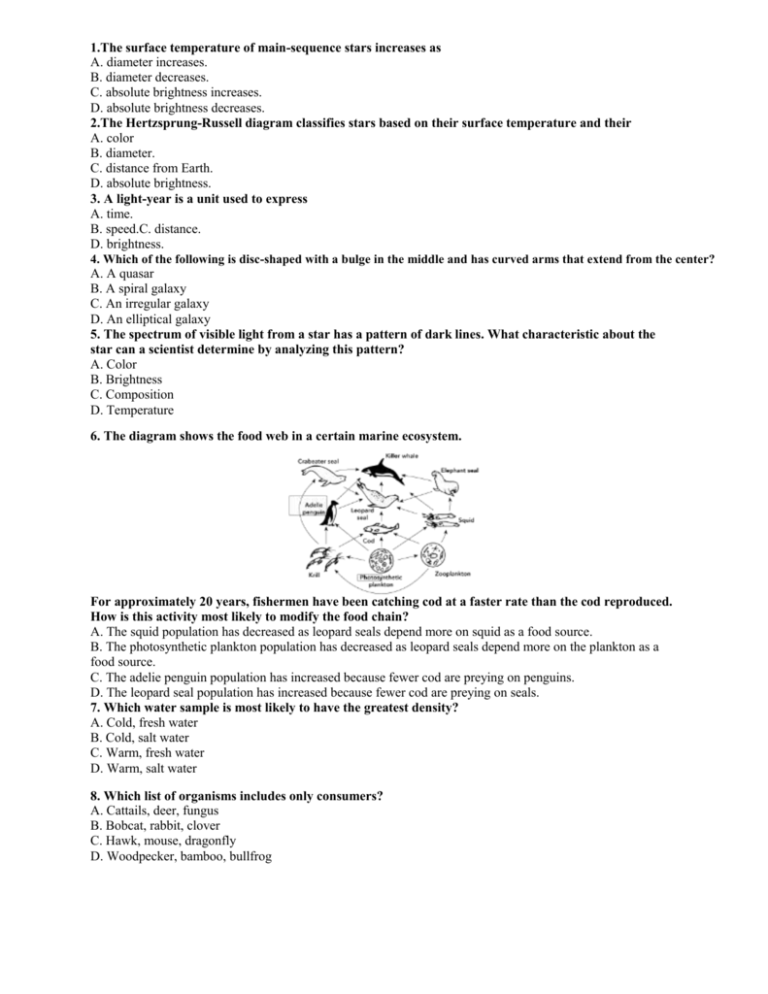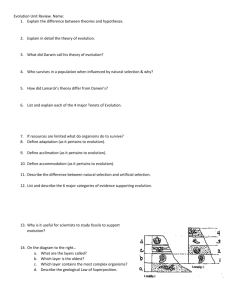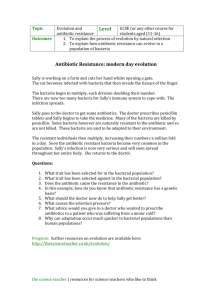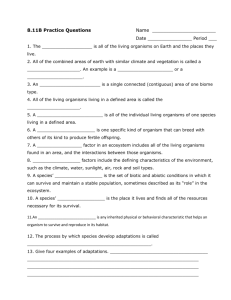1.The surface temperature of main-sequence stars increases as A
advertisement

1.The surface temperature of main-sequence stars increases as A. diameter increases. B. diameter decreases. C. absolute brightness increases. D. absolute brightness decreases. 2.The Hertzsprung-Russell diagram classifies stars based on their surface temperature and their A. color B. diameter. C. distance from Earth. D. absolute brightness. 3. A light-year is a unit used to express A. time. B. speed.C. distance. D. brightness. 4. Which of the following is disc-shaped with a bulge in the middle and has curved arms that extend from the center? A. A quasar B. A spiral galaxy C. An irregular galaxy D. An elliptical galaxy 5. The spectrum of visible light from a star has a pattern of dark lines. What characteristic about the star can a scientist determine by analyzing this pattern? A. Color B. Brightness C. Composition D. Temperature 6. The diagram shows the food web in a certain marine ecosystem. For approximately 20 years, fishermen have been catching cod at a faster rate than the cod reproduced. How is this activity most likely to modify the food chain? A. The squid population has decreased as leopard seals depend more on squid as a food source. B. The photosynthetic plankton population has decreased as leopard seals depend more on the plankton as a food source. C. The adelie penguin population has increased because fewer cod are preying on penguins. D. The leopard seal population has increased because fewer cod are preying on seals. 7. Which water sample is most likely to have the greatest density? A. Cold, fresh water B. Cold, salt water C. Warm, fresh water D. Warm, salt water 8. Which list of organisms includes only consumers? A. Cattails, deer, fungus B. Bobcat, rabbit, clover C. Hawk, mouse, dragonfly D. Woodpecker, bamboo, bullfrog 9. Look for the Gulf Stream on the map below. If the Gulf Stream temperatures were to cool, which of the following could occur? A. The northeast coast of North America would experience cooler, drier temperatures. B. The southeast coast of North America would experience more hurricanes. C. The west coast of Europe would experience more humid, wet weather. D. The northeast coast of South America would experience warmer ocean currents. 10. Directions: Use the graph below to answer the question. Which interaction between the wolf and the deer populations is indicated by the data in this graph? A. Competition B. Predation C. Commensalism D. Mutualism 11. Which list of organisms includes only producers? A. Lily, mouse, earthworm B. Cattail, rose, pine tree C. Fungus, bacteria, catfish D. Grass, mimosa, kingfisher 12. Which of the following is an abiotic factor in an ecosystem? A. Soil B. Grass C. Fungi D. Bacteria 13. Within a flock of birds, one bird can open tougher seeds than all the other birds. Which statement explains why the bird has this unique ability? A. The bird kept trying to eat tougher seeds until it could. B. The bird inherited alleles from its parents that coded for the adaptation. C. The bird decided to adapt to make use of the unused food source. D. The bird observed other birds that could eat the seeds and learned how. 14. Directions: Use the graph below to answer the question. A certain biologist studies the growth of bacteria populations. The graph shows the population growth of bacteria with time. What is a likely explanation for the change in shape of the curve after 6 hours? A. The population entered a seasonally slow growth cycle. B. Immigration of bacteria became greater than emigration. C. Conditions for the population growth improved toward the end. D. Limits on space and food slowed the population growth at the end. 15. In hospital intensive care units, a particular antibiotic is given for certain bacterial infections. From 1983 to 2001, a doctor noticed that some of the bacteria observed in patients had become resistant to the antibiotic, as shown on the graph. Which of the following could explain why this happened? A. Individual bacteria developed immunity to the antibiotic gradually. B. The bacteria population began to rise in number in 1990, introducing many new varieties of alleles, including one for antibiotic resistance. C. By 1990, the bacteria decided to adapt in response to the antibiotic, developing new alleles that were resistant to it. D. The bacteria with alleles that resisted the antibiotic survived each time the antibiotic was used, allowing that particular trait to increase in the population by the year 1990. 16. A population of mice has adapted to an environment with very little surface water. Which statement explains how this population adapted to its environment? A. The organisms learned from one another and developed the adaptation. B. The organisms decided to change and adapt to the environment. C. The organisms never needed much water to survive. D. The organisms with alleles favorable to living with limited water survived and passed on these alleles to their offspring. 17. A student wants to investigate abiotic factors that affect tomato plants. He obtains four identical tomato plants. Which of the following investigations might he perform? A. He could give each plant a different amount of water and then measure how much each plant grows. B. He could vary the number of tomatoes he picks from each plant each day and then measure the number of tomatoes each plant produces. C. He could plant each tomato plant among different types of flowers and shrubs and then measure how much each tomato plant grows. D. He could expose each plant to a different population of insects and then measure how much each plant grows. 18. On Isle Royale, the wolves and moose have a predator/prey relationship. The graph below presents data about how the populations changed between 1970 and 2010. Which of the following could explain the changes in the moose and wolf populations from 1985 to 1995? A. The wolf population decreased from 1985 to 1991 because there were more moose during this time. B. The moose population increased from 1985 to 1995 because there were fewer wolf predators during this time. C. The increase in wolves from 1992 to 1995 caused the moose population to peak because there were more wolves available for the moose to eat. D. The increase in moose population from 1985 to 1989 caused the wolf population to decline because there were more moose available for the wolves to eat. 19. A student is studying a marine ecosystem. She constructs this diagram to organize her observations of the food web in this ecosystem. Which two organisms are an example of a consumer feeding on a producer? A. Arctic cod and beluga whale B. Ringed seal and polar bear C. Animal plankton and silversides D. Algae plankton and animal plankton 20. The graph below shows the changes in a rabbit population over several years. Which of the following factors could have caused the changes observed during the first four years of the study? A. Many of the trees in the forest were cut down. B. There was an abundant amount of grass and plants in the forest. C. The average annual temperature in the forest was a record high. D. All of the other answer choices









